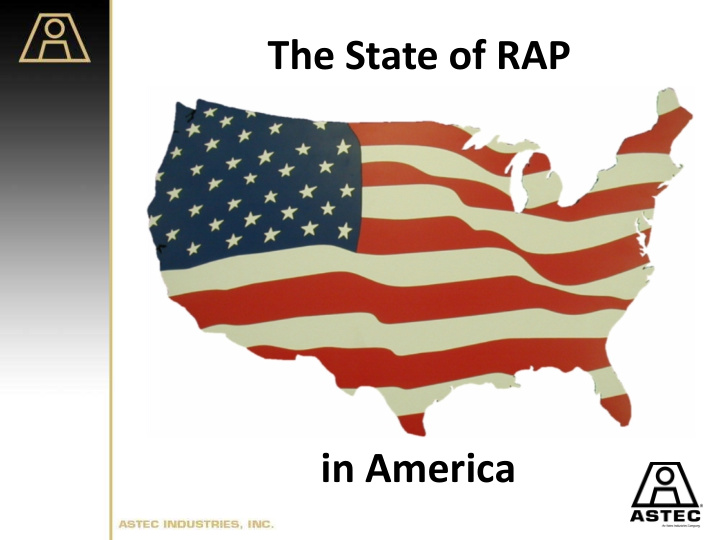



The State of RAP in America
Traditional RAP Wisdom Says… 3 Factors Determine RAP Percentage Used
How Much RAP Does the Producer Have?
How Much RAP Does the DOT/County/Agency Allow?
How Much RAP is your competition using?
How much can your plant handle? Nope…see number #1!
RAP is like money in the bank… …but only if you can spend it!
RAP/RAS Pavement Failures… …and Some Pavement Failures Blamed on RAP/RAS
RAP and RAS - Different Binders Most shingles contain air-blown asphalt cement which is substantially harder than the normal asphalt binder used in a standard HMA mix. A Growing State DOT Perspective =
An Old Irish Blessing “May you have the hindsight to know where you've been, The foresight to know where you are going, And the insight to know when you have gone too far”
RAP in America Where We’ve Been… Where We Are… Where We Are Going…
33 Years Ago
23 Years Ago
17 Years Ago FHWA Superpave Mixtures Expert Task Group developed a tiered approach for RAP usage. • 0 to 15% RAP: No change in the virgin binder grade. • 15% to 25% RAP: Virgin binder grade should be decreased one grade—to soften the blend—on both the high and low temperature scales. • Over 25% RAP: Blending charts should be used to determine required PG grade.
10 Years Ago SUPERPAVE Mix Issues Impacting RAP Mix Performance • High compaction/gyration levels yielded “dry” mixes. • Coarse graded mixes that avoided “Restricted Zone” resulted in increased permeability, low binder contents. • Use of high viscosity(stiff) PG binders made mixes too stiff.
3 Years Ago Turner-Fairbank Highway Research Center High RAP ALF Study • Focus on fatigue cracking of high RAP mixes (20%, 30% and 40%) • Three year completion; 2 ALF units for 2 years of loading allows simultaneous loading • Unmodified binder for all lanes, but 2 different grades • Use of WMA technology that does not change PG grade • 10 kip single wheel = 20 kip equivalent axle • 4-inch total asphalt thickness
Where We Are… NAPA’s Latest Asphalt Pavement Industry Survey on Recycled Materials and Warm-Mix Asphalt Usage Survey responses are 42% of the estimated total tons for the 2015 construction season.
2015 Survey Highlights - RAP +99% of RAP from old pavements put into new pavements. +74 million tons of RAP used in asphalt mixes in 2015. 3% increase over 2014 and +32% increase over the 2009 usage. 1% decrease in respondents using RAP (from 100% to 99%). A few producers reported landfilling RAP in 2015. Estimated 2015 savings from RAP usage; 3.7 million tons of binder and +70 million tons of aggregate ( over $2.4 billion ). Estimated +85 million tons of stockpiled RAP yearend 2015. 23% of RAP used fractionated, 24% of RAP mixes used softer binder, and 3% of RAP mixes used some type of rejuvenator.
2015 Survey Highlights - RAS RAS decreased almost 2% to an estimated 2 million tons in 2015. 2015 RAS still 175% more than 2009. 2015 RAS usage reduced the need for 386,200 tons of binder and nearly 965,500 tons of aggregate , for a total saving of $194 million .
2015 Survey Highlights - WMA • 119.8 million tons produced in 2015 using WMA technologies. • This was an increase of 5% increase over 2014, and a 614% increase from the 2009 construction season. • WMA technologies used in 33% of all mixes produced in 2015. • Plant foaming most widely used technology for WMA (+72%). • At +25%, chemical additives are the second most used WMA technology.
World View on Recycling is Different
British Columbia View of RAP is Different
Where We Are Going… Asphalt Recycling In America
RAP in America – Breaking Ranks Separating RAP and RAS Recycled Asphalt Pavements (RAP) Recycled Asphalt Shingles (RAS) • Aged HMA Binder • Very Hard Air-Blown Binders • Absorbed Binder • Very High Melting Point • Processed Aggregates • Deleterious Materials Issues • How to Soften RAS Binders
RAP in America – Breaking Ranks Fractionation vs Crusher Run Crusher run aggregates in HMA were outlawed by Fractionation provides gradation controls most states years ago due to necessary for higher RAP percentages lack of gradation control
RAP in America – Breaking Ranks Rural Producer vs Urban Producer Little RAP vs Mountains Of RAP
RAP in America – Breaking Ranks DOT’s vs Municipalities Greening the Streets of New York Asphalt pavement is a mixture of stone, gravel, or sand and liquid asphalt. All of those things, if extracted from worn-down New York City streets, are sustainable. Thanks to the City’s roadway resurfacing program, asphalt pavement used on these streets can be recycled into new asphalt and repurposed for locations throughout the five boroughs. Right now, the NYC uses a minimum of 30% recycled asphalt pavement (RAP) to create new asphalt according to Local Law 71. DDC, together with Green Asphalt, wants to make that 100%.
RAP in America – Breaking Ranks Batch Plant vs Older Drum vs Modern Technology Plant type, design and technology have a significant impact of the amount of RAP that be incorporated into mixes they produce.
RAP in America – Breaking Ranks 29
RAP in America – Breaking Ranks HMA/WMA vs Cold Central Plant
RAP in America – Breaking Ranks HMA/WMA vs Cold Central Plant
Thank You! Richard J. Schreck Technical Services and Applications Director Astec, Inc. (804) 356-1864 rschreck@astecinc.com
Recommend
More recommend